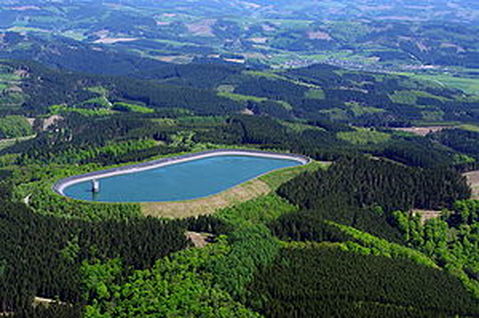|
Each day of COP23, the state of North Rhine-Westphalia is hosting excursions for participants, delegates, observers, and the press, highlighting the actions of the state to promote renewable and sustainable technology. I took part in an excursion focused on hydropower in the southern region of North Rhine-Westphalia (the Sauerland). This trip included a tour of the pumped storage hydropower plant Finnentrop as well as a walk on the Bigge Skywalk, overlooking the Bigge Resevoir. Finnentrop Made up of two artificial lakes at different heights, the Finnentrop power plant, part of Mark-E Energie, is responsible for meeting the energy supply demands of 400,000 people in the Sauerland. The plant is able to assist in managing the fluctuating power demands that occur each day. With an elevation difference of about 280 meters, it takes 300 bars to push the water from the lower reservoir to the upper reservoir. It takes just 70 seconds for the turbines to come to full power, pushing the water up the pipeline. In addition to meeting fluctuating demands for energy that occur in a 24 hour period, the hydroplant is also able to balance out energy fluctuations that occur when other sources, such as wind, are less prevalent. Biggesee Biggesee is an area of recreation that also serves in the provision of energy and water to the region. Although planning for the reservoir reaches back until 1938, it wasn't until 1956 that the government decided to construct the damn, which took 9 years to build. Entire villages had to be moved in order to accommodate the reservoir and citizens of those villages were expected to pay for the supplies with a tax known as the "Bigge Penny", which was one penny for every cubic meter of water they used. In drier times, you can see the tops of the churches and houses from the villages that once stood where the reservoir now is. Today, the lake has many purposes. It provides water for up to 40% of the reservoirs in the river system and produces up to 24 million kWh of electricity a year. Water recreation is very popular, and there is a skywalk that overlooks the reservoir. Images copyright EnergyAgency.NRW Jessica was partially supported by NSF Award Number 1259896
1 Comment
Dylan Miller
10/12/2017 08:13:18 pm
As a civil engineering major, I find this fascinating. I am amazed by how creatively people can use the natural landscape, gravity, and weather to create clean energy. It seems like such a simple solution to our obsession with fossil fuels in America. We need to get more people on board with this in America and start investing in the infrastructure.
Reply
Leave a Reply. |
Categories
All
Archives
March 2024
|

 RSS Feed
RSS Feed
